leguano barefoot shoes – Through Vietnam on quiet soles
My girlfriend and I decided to finally discover the world and start a long journey through Southeast Asia. Leguanos were a must for this adventure...
We were particularly interested in Vietnam, the countless cultures, places that seemed to be from another time, breathtaking nature, the incredible, even tragic history and the legendary cuisine all attracted us.
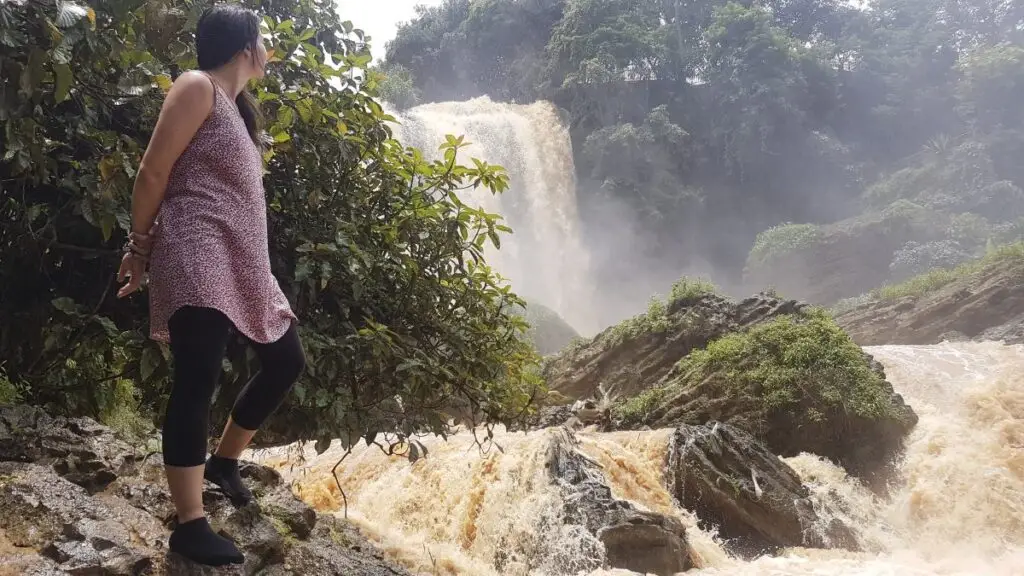
2200 km from north to south – and the barefoot shoes always with you
The flight to Hanoi was booked when we were thinking about what we should pack. I had already infected my girlfriend with my enthusiasm for leguano a few months earlier, so our sneakers were just as naturally on the packing list as our toothbrushes. Traveling barefoot in Asia is problematic, as there is a lot of garbage, poisonous animals and, last but not least, a very hot sun. The loose, airy leguano sneakers seemed to make a lot of sense. This turned out to be true. What we didn't know beforehand was how people would react to the shoes. But more on that later...
We started our journey south in Hanoi, in the north of the approximately 2200 km long country. We set off with dream destinations in our hearts and a three-month visa in our passports.
The North
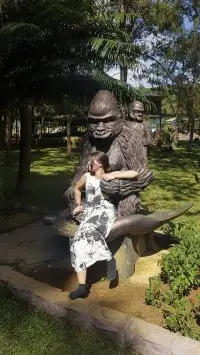
Hanoi is the capital of the country, a colorful and chaotic world. We like to explore on foot, and after a few attempts we learned how to cross the street between all the tuk-tuks, mopeds, carts, minivans and mobile street food stalls: just start walking, keep up the pace and always look. Traffic in Asia may seem like an inscrutable chaos to a European, the rules more like guidelines that no one follows. Despite this, accidents are less common than you might think. The secret is that everyone looks out for each other. They don't insist on giving way, but rather slow down and see how best to get in each direction. Actually, a much more considerate way of dealing with people than we are used to in Germany. You rarely see anyone swearing either. Why get upset?
And in the middle of the hustle and bustle and honking, the two tourists are walking... in socks? No, they still have soles on them. People often looked at us. The years when you meet people who have never seen a western person are certainly over. But these shoes always caused surprise. If it weren't for the language barrier, we would have advertised every day. For half a day - it was a bit cloudy and rainy - I walked without shoes. After two minutes, my feet were pitch black from the smog, dust and dirt of the street. The leguanos protected our feet and we explored the temples, museums, districts and of course the cafés on foot.

But as lively and fun as the city may be, after a few days you want to escape the smog. So we drove to Cat Ba, the largest and most inhabited island in the famous Halong Bay. Huge karst rocks that rise out of the sea and, according to legend, were spat into the sea by three dragons to protect the Vietnamese. Half of the island is a national park, flat jungle and hills as far as the eye can see. Climbing the steep and slippery slopes was a welcome change from the cramped city. Lianas, countless butterflies, never-before-heard bird songs and a breathtaking view from the top of the mountains gave us a warm feeling of freedom. The shoes coped really well with that, by the way. Fantastic grip.
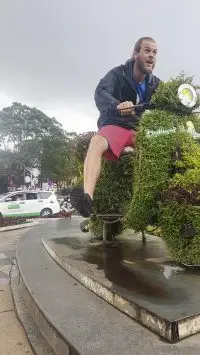
As we all know, a family of five with a dog or a refrigerator can fit on a small "motorbike". We also spotted several pigs on the luggage rack, as well as a mechanic who was transporting another bike on his. Now I also like riding and I get along wonderfully with the local riding style, but is it possible with barefoot shoes? Kickstarter, gear shifting, holding the bike when things get tight? I just tried it out and yes, it works really well.
Then we took the bus to Ninh Binh. The area there is also called dry Halong Bay, meaning karst rocks with no sea in between, but endless rice fields, rivers and wonderful nature. There are many beautiful viewpoints and pagodas on the rocks in the area. Wherever you are in Vietnam, weddings and wedding photos are omnipresent. Here too, on an 800-step viewpoint. When you get to the top, you are more than exhausted. But the brides do it in high heels and wedding dresses so that they can look good on a dangerous rock ledge. Rumor has it that some Vietnamese women even wear their hair curlers to the top. But we were real eye-catchers with our shoes, and people asked us about them.
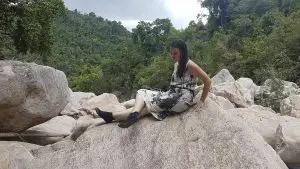
We explored the surrounding area by bike, motorbike and on foot, discovered lotus ponds, caves and the local specialty: mountain goat. After a spontaneous round of karaoke at a family's home, we suddenly found ourselves on an extended family outing; we took a boat to hot springs beneath a Buddhist temple. Hidden in a small, secluded valley we found a newly created lake. And of course, wedding couples. On a walk you come across so many animals, mostly wild, cows, pigs, water buffalo, goats, dogs (sometimes furless at a food stall by the side of the road) and sooooo many frogs in the damp fields. Every now and then you can also hear monkeys roaring from the rocks. Wonderful.
After a boat trip through rice fields and caves, we met some fantastic people. The next day, the five of us wanted to enjoy a long boat trip as early as possible and therefore in complete solitude, including through the film set of "King Kong 1". We had not taken into account the waking habits of domestic tourists and the day of the week - Sunday. There are probably more photos of us now than of King Kong's handprint. Of course, the shoes were also photographed and admired.
We took the bus to Phong Nha to explore fantastic caves, nature and the jungle. We got lost in a village and played volleyball with the locals. It's a national sport. Climbing eight kilometers through the young jungle was a special experience. Despite the high humidity, our feet stayed dry.
The hotly contested middle
Next stop: Dong Hoi. There are two guesthouses there, and everyone is really happy to see a stranger. You hear a friendly "Hellooo" all the time. The beaches there are truly beautiful, partly untouched, and we can only hope that major investors will not discover the area for themselves. Unfortunately, our day of beach discovery encountered a small problem: the sand was far too hot and jellyfish washed up. But taking iguanas into the salt water? That could be a death sentence. Well, we needed them for protection, and tried not to come into contact with salt water. Unlike my belt, however, they survived the trip without a problem.

In Dong Ha we immersed ourselves in recent history. Vietnam and Germany actually have a lot in common, supposed communism and trade relations, and also a divided past that was resolved in reunification. With the best guide we went into tunnels in which the so-called Vietcong hid relatively successfully from US air raids.
Thousands of people were housed in these tunnels at one point. On three floors, up to 30 m deep, there were operating rooms, common rooms, kitchens, family rooms the size of bathtubs, schools and, of course, weapons and ammunition depots. History you can touch, visible in the form of Agent Orange-contaminated forests and countless bombs and ammunition casings. But also invisible: napalm, Agent Orange and more bombs than in both world wars combined rained down on the country here during the war.
Thousands of mines and bombs are still hidden throughout the country, especially in central Vietnam, and people are still suffering from explosions. German and US organizations are taking care of reconnaissance and clearance, including in Laos and Cambodia. It is amazing that the USA is viewed very positively here. We have learned from those affected that some things can be forgiven...
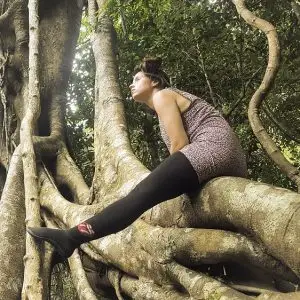
The City of Arts was our next destination: Hue. Everything is a bit cleaner and exudes history. The old royal citadels, the parks by the river. I ate an egg with a chick, a local specialty. Very tasty! One of the best places there was a silk weaving factory. Incredibly beautiful handicrafts, the colorful embroidery really leaves you speechless.
From Hue to Da Nang, the third largest city with 1.1 million inhabitants, you pass the famous Hai Van Pass. We took the train, the "Reunification Express". Incredibly beautiful views. We just rode there again on our motorbike. The city is proud of its original bridges, for example the Dragon Bridge, a huge, drivable dragon that spits fire and water on weekend evenings. We went to a fascinating museum about the Cham dynasty, an ancient civilization that produced temples as fascinating as those of the Angkor period. A little younger, probably 800 years old, is a banyan tree there, which we climbed like the monkeys that live there.
We moved on to Nha Trang, near a place called Cam Duc, where we taught English for a week. It was a nice, stressful but rewarding experience. We taught little ones, teens and adults. We also spent two more days in Nha Trang at another school run by this team. It was a lot of fun. We then spent a few more days there, tried some really delicious food and climbed a wonderful waterfall.
Away from the coast, into the mountains
Suddenly cool temperatures, wine, strawberries and lots of rain. A feeling of home. This health resort was "settled" by a fantastic person called Yersin. Until his time, only so-called minorities such as the Mnong, Ede or Lak lived here. The latter gave the present-day city its name: Da Lat. Monsieur Yersin himself is the discoverer of the plague virus, but the Vietnamese celebrate him above all for his meteorological knowledge and his ability to predict typhoons and monsoon storms. On a hike in heavy, continuous rain, the sneakers reached their limits. I had bought waterproof socks, however, and the combination rocks! My feet stayed dry, but unfortunately my loved one's did not. They dry very well here overnight, though.
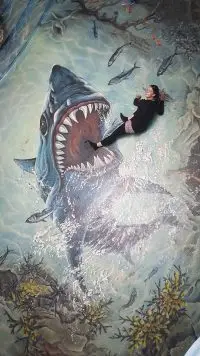
The place is now a big city and a tourist destination for locals. There is so much to see, farms, a few forests, flowers... and of course incredible views of the mountains. We visited the Crazy House, a project by an architect who reminded us of Salvador Dali. A bit crazy, very playful and a fun place to get lost in the buildings. Most of Vietnam's coffee, fantastic coffee by the way, also comes from here. What the French once "forcedly imported" has been developed by the climatic conditions and the slightly different processing ideas of the Viet into a slightly different coffee.
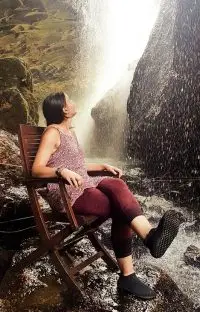
The city of Buon Ma Thuot is located near the border with Cambodia in a region where many minorities and elephants also live. The landscapes are incredibly beautiful, varied and expansive. We discovered Lake Lak, special houses on stilts and the most beautiful waterfall here! We stayed with a family who lives in a small town outside of the city and had a lot of fun and impressions.
The area is very, very poor. The roads are barely paved, there are lots of people who simply cannot afford a motorbike, and oxen instead of agricultural machinery. There is also a coffee museum, which is very interesting not only because of the building but also because of the history: a coffee fan from Hamburg founded a museum, but it didn't go well, so he simply moved the entire museum to where the probably most underrated coffee in the world grows: Vietnam's plateau.
The South
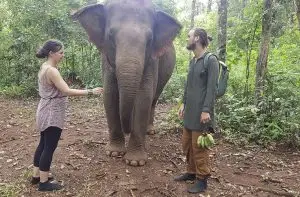
On the way to Saigon lies what is probably the last real rainforest in the country, the Cat Tien National Park. Since the US commanders did not suspect that there were any fighters there, no bombings were carried out. Old trees guard this mystical forest, each one is an individual. Their roots are the foundation of the habitat in which so many animals live. Giant spiders, large families of butterflies, Siamese crocodiles, some endemic ungulates, lorises, gibbon monkeys and an almost incomprehensible variety of bird species can be discovered here. What you cannot discover, but what do live there, are big cats and elephants. They live in the excellently protected part of the rainforest on the border with Cambodia, and that is a good thing. The animals also live in Cambodia. After all, what does an animal care about a man-made border...
Finally we arrived in Ho Chi Minh City. We were a little lucky with the weather, because the city is actually super stuffy and hot. But the rainy season was slowly setting in. It is becoming more unreliable with each passing year - global warming is saying hello. But that suited us just fine. Lots of art, lots of big city. More expensive, more modern and hipper than the rest of the country. We were on the 52nd floor of a tower, and the impressive view costs German prices for a drink, but it is definitely worth it!
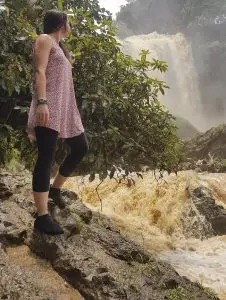
We spent the last few days in the delta of the gigantic Mekong, whose countless waterways disappear here. It is probably more reliable and quicker to get from A to B by boat. We went on a tour of the floating markets in Can Tho, visited a cocoa farm and a small "noodle factory" and chugged through one of the never-ending canals. And the culinary discovery of the day is a "Co-Coa" liquor: not the chocolate bean, but the pulp of the tuber is fermented. Insanely delicious!
At the southernmost point of the Vietnamese mainland, near Ha Tien, we crossed the border into Cambodia after around 90 days. We had covered 2036 km. Amazingly, our barefoot sneakers are still going strong after almost daily and very intensive use. They have survived thorns, mountains, cliffs, beaches, heat and water. The leguanos will probably accompany us for some time on our next adventures. In Cambodia.
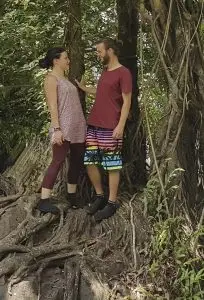
Greetings from there Kri and Chri